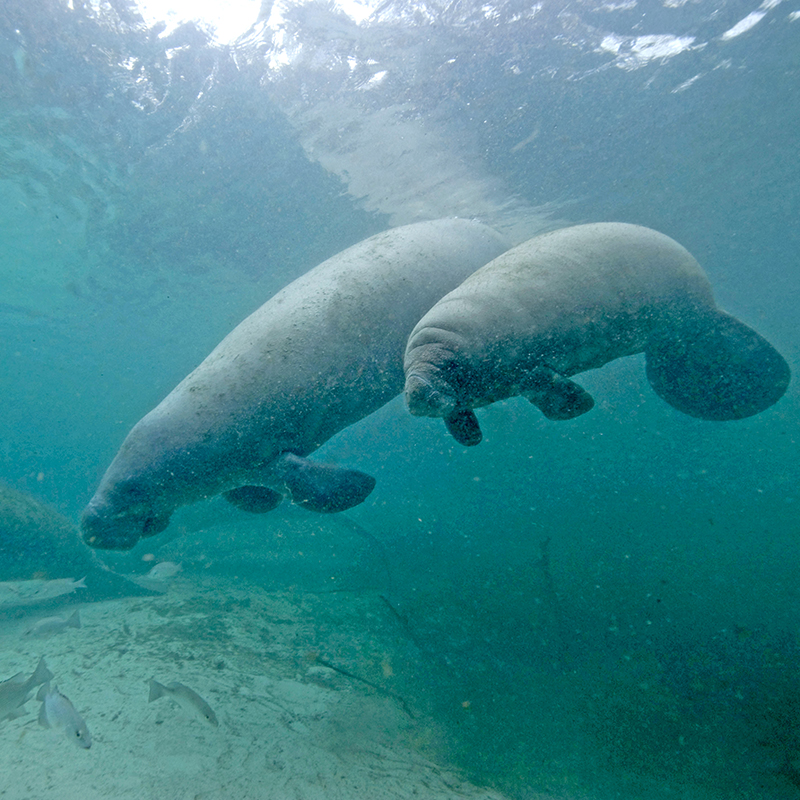Students will learn about the biology and ecology of cetaceans (whales and dolphins), and learn ways that humans impact and can protect cetaceans.
Lesson Plan
Manatees
Grade Level: 3
Students will learn about the biology and ecology of a manatee as well as learn ways that humans impact and can protect manatees.
Lesson files
We’d love your feedback! If you’ve used Florida Sea Grant’s educational curricula or activities, please fill out our short online evaluation.

Lessons
This curriculum provides a series of individual lessons covering manatee biology and ecology, as well as highlighting some of the ways that humans impact and can protect manatees. The curriculum has been written at a third grade level but can be adapted for older or younger students. Lessons are designed to take approximately one class period each (exceptions are noted in the lesson descriptions).
Lessons are listed in the suggested order; however, each one is a stand-alone lesson that could be taught independently of the others. It is suggested that teachers integrate these lessons into their regular curriculum, mostly in the fall semester, culminating with a field experience in the winter (December through February), if feasible, and a school manatee science night in the spring.
Reading & Instructional Materials
Students will create a K-W-L chart and will learn about manatee biology by reading the book, Sam the Sea Cow.
Reading & Instructional Materials:
Students will watch the Reading Rainbow program based on Sam the Sea Cow and will complete a worksheet.
Reading & Instructional Materials:
Students will learn about what an adaptation means and how manatees are adapted to their aquatic environment.
Reading & Instructional Materials:
Students will learn characteristics of mammals and will use observation skills to list similarities and differences between manatees and their close relative, elephants.
Reading & Instructional Materials:
Students will learn about different species of Sirenians, and will use maps to locate where each species lives.
Reading & Instructional Materials:
- Lesson 5: Manatees and Their Cousins
- FWC Manatee Activity Book
- Request printed copies of the activity book via the Florida Fish and Wildlife Conservation Commission‘s website.
Students will attempt to hatch brine shrimp in water of different salinities to learn how changes in the environment affect survival of animals. This activity has three parts and will take approximately 2.5 class periods over a 1-week timeframe.
Reading & Instructional Materials:
Students will learn about plant biology, herbivory and what manatees eat. Students will realize that all plants are not the same and the manatee has some that it prefers.
Reading & Instructional Materials:
Students use math skills to calculate manatee feeding needs.
Reading & Instructional Materials:
Students will understand thermal refuges and manatee winter migrations. You may want to spread the components of this lesson over two class periods.
Reading & Instructional Materials:
Students will learn that different activities create different amounts of pollution.
Reading & Instructional Materials:
Students will learn what types of items are biodegradable and what types are not. This lesson requires two class periods about one week apart.
Reading & Instructional Materials:
Students will learn about threats to manatee survival.
Reading & Instructional Materials:
Students will learn about factors that can affect manatees in their migration to find warm water in the fall and winter months. Students will work together to complete a successful manatee migration.
Reading & Instructional Materials:
Students will use quizzes to test their knowledge about manatees.
Reading & Instructional Materials:
Students will learn how scientists identify and track individual manatees.
Reading & Instructional Materials:
Students create podcasts/PSA’s/posters to teach others about ways to protect manatees. This may take 2 or more class periods.
Reading & Instructional Materials:
Students will complete a field study activity at Blue Spring State Park. Teachers should review the field data sheets with the class within a few days of the visit and should review and complete their KWL chart.
Note: During winter months, you can view manatees via live webcams at Blue Spring State Park. Archived videos are also available.
Reading & Instructional Materials:
Students and teachers will prepare for Manatee Night.
Reading & Instructional Materials:
SaveTheManatee.org
- During winter months, view manatees at Blue Spring State Park and Ellie Schiller Homosassa Springs Wildlife State Park via live webcams.
- Listen to the different sounds manatees emit underwater.
Florida Fish and Wildlife Conservation Commission
Manatee Education Videos
Adapted for individual learning
Manatee Education Videos
More Information
The manatee outline can be printed or copied to use with this lesson.
Acknowledgements
This curriculum was designed in 2009-2010 by Dr. Maia McGuire, Florida Sea Grant Associate Director for Extension and Education, and Dr. Ruth Francis-Floyd, UF/IFAS Extension Veterinarian, with assistance from Alexis Morris and Maxine Floyd. The lessons were reviewed and updated in 2021. Sunshine State Standards (science) and/or common core standards are provided for each of the lessons. The authors thank the Florida Fish and Wildlife Conservation Commission for their financial support of this project, and Nina Youngman and Kristi Booth for pilot-testing several of the lessons.
Explore More Lesson Plans
Students will learn about the biology and ecology of sea turtles and the ways that humans impact and can protect them.